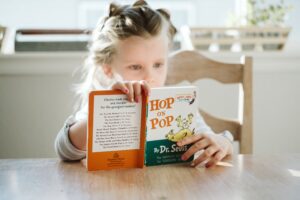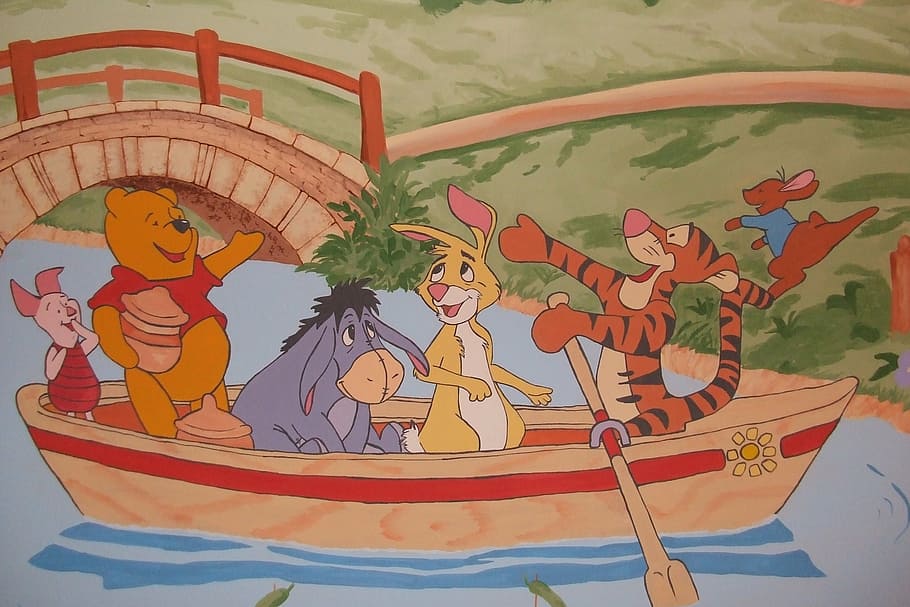Children’s literature is a genre that focuses on simple storytelling for the sake of its audience’s understanding, but also often incorporates life lessons that help young people navigate challenges such as friendship and family. One common way that children’s literature does this is through the trope of the “found family”–a group of non-biologically related characters that form bonds that enable them to act as an interdependent unit, similar to a biological family. A.A. Milne’s Winnie the Pooh features a found family whose real animal counterparts would be unlikely to get along but who continuously work together to solve many challenges they face. The story follows Winnie-the-Pooh, Christopher Robin, Piglet, Eeyore, Tigger, Rabbit, Kanga, Roo, and Owl in a variety of stories about challenges they face, such as running from imaginary monsters to finding a missing tail.
The theme of friendship is very common within this type of literature as it is the first challenge children are likely to encounter in school. While children’s literature has the potential to teach many lessons through very literal depictions, lessons of friendship are often implied within a text rather than explicitly stated. The trope of the found family in Winnie the Pooh is a good example of this phenomenon. Throughout the book, the characters act not only as friends but as a found family made up of members that rely on one another much like those in a blood-related family would. This trope’s presence in a children’s novel is interesting–it teaches children about the possibility of creating friendships stronger than family bonds, which is different from traditional friendship narratives that portray both relationships as potentially coexistent.

While many understand the educational value of children’s literature, critics have also questioned its aetonormativity, or the idea that whatever is presented as “adult” is implicitly more worthy whereas anything presented as “childish” is less worthy. Critics worry that despite any explicit lessons an author may attempt to teach, they may also inadvertently perpetuate the idea that any “childish” behavior is wrong. Within the trope of found family, we could also expect to find this kind of hierarchical dynamic by having some characters acting as ‘parents’ to ‘children’ within the group; however, Winnie the Pooh resists this impulse by placing characters on equal footing, thus combating traditional children’s literature’s aetonormativty.
The story of Winnie the Pooh exemplifies this idea by showing the nature of interdependence within the family-friend group. An example of this interdependence comes when Eeyore loses his tail and the group has to work together to find it. Eeyore’s general hopeless demeanor is increased by the situation, which leads Pooh and the others to attempt to find solutions in order to restore his happiness. According to Shivi in their article A. A Milne’s Eeyore: A Peep into the World of Clinical Depression, this scene shows that Eeyore has no independence or sense of self without his friends and that he is entirely reliant upon them for his happiness. This sort of dependence is not unique to Eeyore, as all the other characters also attach their individual identities to the group. In this way, they have formed much more than a friend group; they act as an interdependent family structure based on non-blood relations.
In the book Perfecting Friendship: Politics and Affiliation in Early American Literature by Ivy Schweitzer, it states that this idea of a “found family” is often associated with Aristotle’s notion of philotes, frequently translated as friendship, a concept that has informed philosophical discourses surrounding the concepts of sameness, difference, and equality within these relationships. The concept was integral to ancient Greek society in that they used the term to describe one’s blood-related family, as well as those to whom one felt an equal attachment, regardless of relation. Their understanding created strong cultural relations wherein individuals often relied more strongly on their peers and friends than family for support, which some have argued contributed to their strong sense of militaristic association. As with any society, these values were passed on to children through a variety of methods, including oral storytelling traditions. Today, while we place less cultural emphasis on these friend-family structures, we still understand the educational value of friendship narratives and found families. The trope of found family, in this respect, is not a modern concept, although, many claim Milne was integral to its modern popularity.

The educational value of Milne’s story within the children’s literature genre has also been critiqued for its lack of explicit life lessons. Maria Nikolajeva notes in her book Reading for Learning: Cognitive Approaches to Children’s Literature that scholars of children’s literature have long theorized that stories grounded in realism allow children to subconsciously understand many of the work’s themes. She also states that other scholars have suggested that fantastical worlds benefit the childhood development of imaginative thinking. Milne’s story relies upon these implied lessons but uses an entirely fantastical world. The didactic nature of children’s literature is one that scholars continue to study as the argument remains as to whether authors act more as teachers or artists. The criticism of Milne’s story as lacking in educational value and employing a fantastical setting that may inhibit its pedagogical potential thus serves only as an extension of this discussion, rather than a repudiation or reinforcement of literary traditions.
Despite these critiques, Winnie the Pooh is successful in repudiating the tradition of aetonormativity within the found family trope. The story has an equal power structure, which is not common in children’s literature or within the found family trope. Traditionally, the idea of a found family implies that within a group, each member has a different role and differing power, as with a blood-related family. This narrative differs in that each of the characters maintains equal power dynamics. Clémentine Beauvais states in their review article The Problem of ‘Power’: Metacritical Implications of Aetonormativity for Children’s Literature Research – Children’s Literature in Education that the aetonormativity of the genre stems from the fact that most children’s stories feature a child-adult power dynamic written by an adult author with the understanding that the story must receive the approval of adults in order to become a successful publication. This ascendency within the genre reinforces oppressive aetonormative ideals and limits the childish freedom of readers. Milne successfully deviates from this norm in that the story features no child-adult or age-related power dynamics and allows the characters to act childishly without criticism. The characters often find themselves facing comical issues that they have created for themselves, which then requires teamwork to solve their issues.
While the situations they face often seem childish or related to their lack of critical thinking skills, they do not face scrutiny for their mistakes, as often happens in literature with an adult power dynamic. In this way, Winnie the Pooh positively repudiates tradition and teaches children that their age-related shortcomings are not deserving of scrutiny, rather it proposes found family structures and teamwork as a solution. Regardless of the criticism of the didacticism of fantastical settings, this story retains important lessons and a new divergence from the traditions of children’s literature.

